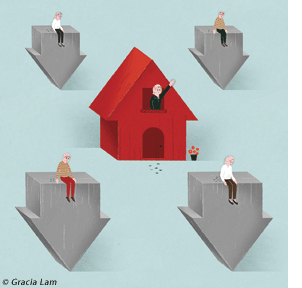
In the aftermath of the subprime mortgage crisis—whose effects continue to reverberate, with foreclosures still high by historical standards and private investors reluctant to get back into the mortgage market—there’s been no shortage of finger-pointing. People have variously blamed government programs, the private sector, the practice of mortgage securitization, greed, and stupidity for the mess.
Greed and stupidity will always be with us. But what about some of the other things? Do government programs—or private-label mortgage-backed securities, or Fannie Mae and Freddie Mac—have a part to play in American homeownership? For answers to those questions, and a prescription for a more sustainable future, you could hardly do better than to ask Susan Wachter, the Richard B. Worley Professor of Financial Management at Wharton and co-director of the Penn Institute for Urban Research.
Wachter, most recently the editor, along with Marvin Smith of the Federal Reserve Bank of Philadelphia, of a University of Pennsylvania Press volume titled The American Mortgage System: Crisis and Reform, sounded the alarm early on. In papers like “The Inevitability of Market-Wide Underpricing of Mortgage Default Risk,” co-written with Andrey Pavlov for the journal Real Estate Economics in 2006, she pinpointed some of the structural problems that would soon wreak devastation on the financial system. In the years since, she has testified before committees in both chambers of Congress about how to move forward. In September, she spoke with Gazette associate editor Trey Popp.
Some people see the mortgage crisis as a pretty straightforward story: Americans were simply willing to do anything to buy a home, and the government was ready to help them, through various programs and policies. What do you think?
While in some ways the culture of homeownership at any cost may be a contributory factor, if you look into the long-term homeownership programs that we have on the books—like the Community Reinvestment Act—they are culprits that are very difficult to pin the blame on. The timing is just wrong. First, these programs have been in place for decades. Second, actually the loans of these programs have been performing relatively well. Third, at the same time we had a boom-bust crisis, we also did in commercial real estate—in fact, commercial real estate collapsed more significantly in terms of price decline, 40 percent versus 30 percent. And of course there’s no Community Reinvestment Act for commercial real estate. So I think we have to look elsewhere for more specific factors as far as the mechanics of the build-up and the collapse.
You’ve argued that this was a supply-side crisis. What does that mean, and what lessons does it hold for reforming the system?
It’s a puzzle why the markets did not respond as they normally should, and would, with a pricing signal. That is, when risk increases, so should the required rate of return. That pricing signal was missing in action. And that’s what we point our fingers to, the absence of the market signal.
What we attribute that to is that there were these complex mortgage instruments that were totally non-transparent, in opaque portfolios. Bank portfolios themselves cannot be easily tracked. The instruments did not have to be marked to market, they were “marked to model.” That is, their value was not actually tested in the market. So we’re talking about mortgage-backed securities but then also CDOs [collateralized debt obligations], and CDOs squared, and synthetic CDOs, which were adding leverage without pricing the increased risk. These instruments were being held as though they were risk-free AAA instruments throughout the world, by pension funds in [places like] Denmark and Norway, who bought them assuming they were never going to fail—that they were in some sense like the securitizations that had backed our mortgage system in the 1980s and ’90s.
But starting in 2002 and 2003, the composition of our mortgage securitizations—we’re talking about a $5 trillion-plus pool—shifted remarkably and rapidly through private-label securitization, which were not standardized, and which had as their product multiple very risky mortgages, like what became known as NINJA [No Income No Job or Asset] mortgages. It happened very quickly, and was impossible to track. The securitizations these mortgages were bundled in did not reveal much. And besides, in retrospect, much of the data made available to investors were invalid. So, for example, properties would be listed as owner-occupied which were not owner-occupied. Loans were represented as income-verified when they weren’t. This is a story that’s becoming more understood.
The 30-year fixed-rate mortgage has been the bedrock of American homeownership for about 75 years—but it’s not nearly as common in a lot of other countries. Does it have a future here? How can we hold onto that option without taxpayers being at risk for another crisis like the last one?
If we are to have a 30-year fixed-rate mortgage—and we think it’s a good idea to have a 30-year fixed-rate mortgage—then we need securitization. Now it is true that we have many peer countries without a fixed-rate mortgage. The adjustable-rate mortgage has worked well in many of these countries. The problem, which these countries themselves are addressing now, particularly in the UK where the short-run variable-rate mortgage is pervasive, is that it opens the economy to interest-rate risk through the household sector.
So in a time when mortgage rates are, like today, say 4 percent, what would happen if we all had 4 percent mortgages, and we were paying 30 percent of our income, which is typical—and then interest rates globally increased to 6 percent, which is not unheard of at all? Then our payments would increase by 50 percent. That would be an equivalent crisis to the one we went through with teaser-rate ARMs [adjustable-rate morgages], which was basically at the heart of the subprime debacle. Teaser-rate ARMs, where rates went up 50 percent or so—they could go up that much, or more—forced people to refinance, but they could not refinance in a moment of global financial crisis.
So what I would say that I have brought to the table, with my colleagues and co-authors, is that the undermining of lending standards, and the deterioration in underwriting, occurred along with and was causally related to an increase in housing prices. In those parts of the country where lending constraints were overcome by the easing of underwriting, constraints that had been in place were removed, loans were made, and demand went up, and housing prices went up. It was unstable because it depended on ever-decreasing underwriting standards, and there’s a limit there. And it was unstable because these underwriting standards were not consistent with long-run sustainable homeownership.
What’s the solution?
In 2005 and 2006, the Fed was very aware of the “house-price bubble.” But the Fed was not aware of the deterioration of underwriting standards. The data were not there. In some ways, the data were there—there was an overwhelming amount of data—though not valid, not tested for, not certified, and often wrong. The problem was that with the huge variation, the heterogeneity, of these ways of moving back from the standard mortgage [by the rapid creation of niche products], it was very difficult to track where this was happening and how much it was happening. Putting together an index of risk was basically impossible—we tried, actually—because of the lack of standardization. So that’s the way forward. Investors and regulators need to know what’s happening to the book of business, because the book of business affects everyone’s risk.
It’s very important for us, right now, to start developing a consensus of what to do. Clearly Fannie and Freddie, as many people agree, did not cause the problem, but they piled on and made the problem far worse. We need to restructure Fannie and Freddie. We can’t just do away with them without having a replacement, because we wouldn’t have a mortgage market without them. Ninety percent of our mortgage market today is Fannie/Freddie and FHA. So simply shutting that down would not work.
So what is your proposal?
My proposal is for more information. If we have transparency about what’s in mortgage-backed securities, there’s a scenario in which the private sector does do securitization. However, in the short run, it’s highly unlikely we will have a market without the government having a significant role. Because of the risk, the private sector simply has not stepped up. The private sector has returned to commercial mortgage-backed securitization, but it’s clear in the residential mortgage-securitization market that the rules of the game are broken, and the private sector fears to get back in.
When you talk about transparency, what should that entail?
Well, the mortgage product itself. I’m not saying there should not be be niche products, but there should be a standard mortgage, as we did have: long-term, not necessarily 30 years, but a standard mortgage product with terms to be easily understood. Secondly, the underwriting, and third the securitization itself, and fourth the servicing. These are very complex. But industry people understand that we did have standardization. That’s one thing that Fannie and Freddie did deliver—and then of course they helped to undermine it, by buying up nonstandard products.
Finally, there needs to be information standardization—as we do with any security. It’s interesting that mortgage-backed securities, which are the most important asset class, and the asset class that banks rely on for their own financial stability, do not have transparency requirements. Clearly they should.




